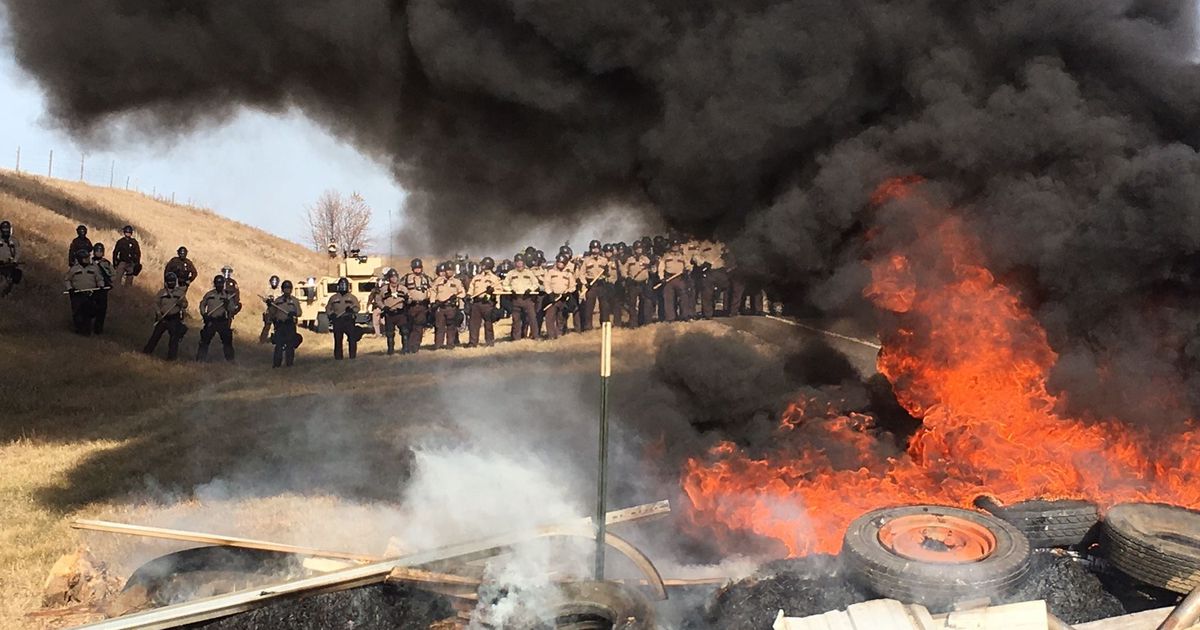Dakota Pipeline protesters forced back by police


Only a little more than two weeks after actress Shailene Woodley was arrested at a peaceful protest in North Dakota, law enforcement returned Thursday with mace, rubber bullets, water blasts and sound bombs. Nearly 200 protesters were no match for authorities, who forced them off a camp set up to block the construction of the Dakota Access Pipeline.
Police arresting some of the protesters amid the chaos at a make-shift camp built on private land near Cannon Ball, North Dakota. The activists had moved from their main camp on federally owned land, where thousands have been living and demonstrating for months, to land owned by pipeline developer Energy Transfer Partners, about 2 miles north.
Reports from social media show tear gas, rubber bullets and water canons being used to remove the protesters.
The scene about an hour ago on Hwy 1806 as policr attempt to force Oceti Sakowin Sioux tribes to allow DAPL on their treaty land. #NoDAPL pic.twitter.com/wG4SXXrKAE
Unicorn Riot (@UR_Ninja) October 27, 2016
Arrest being made, police getting rubber bullets ready at #NoDAPL pic.twitter.com/PhFPOKwoj9
Jeremy (@jeremyltn) October 27, 2016
Police in riot gear are pushing in on Native American media airing live footage. #NoDAPL pic.twitter.com/ESuzHvbLCf
Simon Moya-Smith (@SimonMoyaSmith) October 27, 2016
Independent filmmaker Romin Lee Johnson is at the protest making a documentary. He told Mashable in a phone call Thursday afternoon that he’s seen people get maced, shocked with a Taser and hit with rubber bullets.
“This is the biggest show of force, by far,” said Johnson, who has been coming to the camp intermittently since September.
He said after the new camp went up Sunday he’s seen ATVs and military vehicles come through.
Officers formed a horseshoe-like loop around the camp Thursday and started making arrests mid-day, according to the Associated Press. A local radio station reported 16 arrests as of Thursday afternoon.
16 arrests at DAPL today…. #kfyrkafe
KFYR AM 550 (@KFYR550) October 27, 2016
The pipeline project received a spike of attention after Woodley was arrested earlier this month. Thursday’s police action triggered a fresh interest in the protest, according to Google Trends.
What is the pipeline
The pipeline would be more than 1,000 miles long and transport crude oil through Standing Rock Sioux Tribe lands. Environmentalists and indigenous groups have been fighting to stop the project, which if completed would carry 570,000 barrels of light crude oil per day from North Dakota’s Bakken and Three Forks shale formations to Patoka, Illinois, passing through South Dakota and Iowa along the way.
A section of the Dakota Access Pipeline would run underneath the Missouri River, a federally protected waterway. The Standing Rock Sioux Reservation home to roughly 15,000 members and spanning 2.3 million acres lies just upstream from that river crossing.

Armed soldiers and law enforcement officers moved in Thursday to move Dakota Access pipeline protesters off private land in North Dakota.
Image: Mike McCleary/The Bismarck Tribune via AP
North Dakota Gov. Jack Dalrymple said the Morton County Sheriff’s Department and North Dakota State Highway Patrol had been successful in clearing the new camp and had arrested anyone who had not left the area voluntarily. There were no serious injuries, he said in a video of a press conference posted to Facebook.
“Private property is not the place to hold a peaceful protest,” he said.
Johnson said the police line is continuing to push demonstrators off the land and back to the main camp, which is on U.S. Army Corps of Engineers property. The day prior to Thursday’s confrontation, authorities had brought in Humvees and buses and ordered the protesters to leave.
History of the protest
The pipeline protest has been lightly covered outside of smaller news outlets, but Thursday’s crackdown at the camp on privately owned land appears to be a tipping point. CNN was on the ground covering the police action and Johnson said reporters for bigger outlets such as the Wall Street Journal had arrived.
“This is what it’s all about,” protestor says. “Sacred water.” Not sure guys on left agree. #NoDAPL #DAPL pic.twitter.com/vHPRC2OHU5
wes enzinna (@wesenzinna) October 27, 2016
On social media, supporters were tweeting up a storm under the #NoDAPL hashtag and Facebook Live videos were streaming updates about police efforts to remove protesters. Johnson said signal is spotty so it has been difficult for supporters to show the protest via social media and video.
People on barricades are peaceably retreating
right now. “It’s a protest, not a fucking war.” –#standingrock local #NoDAPL #DAPL pic.twitter.com/4s6cZ1t45pwes enzinna (@wesenzinna) October 27, 2016
Celebrity support
Celebrities have also been rallying behind the cause, like Woodley and actor Mark Ruffalo. They have given the issue more traction and visibility. Ruffalo took to Twitter amid the demonstration to call for politicians to keep pipeline construction protesters safe.
.@NDGovDalrymple & @Potus the world is watching! We’re calling on you to stop the police escalation at #StandingRock now! #WaterIsLife
Mark Ruffalo (@MarkRuffalo) October 27, 2016
Read more: http://mashable.com/2016/10/27/dapl-protest/